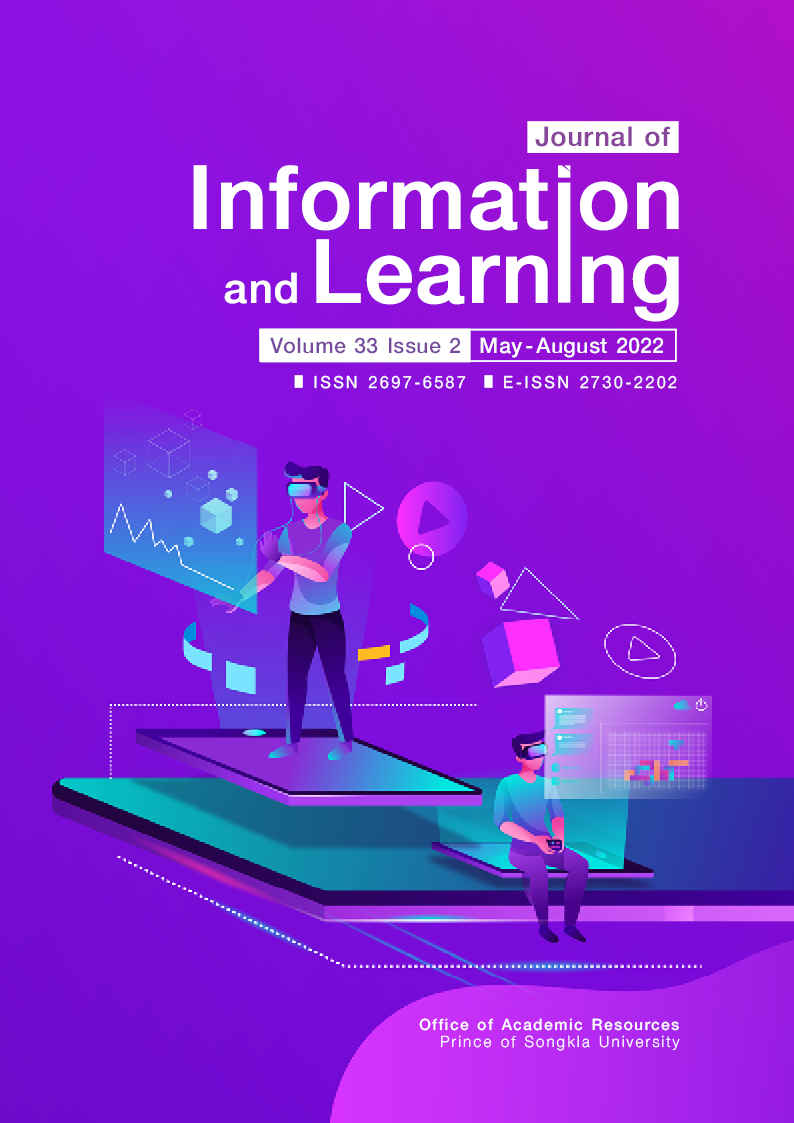Comparison of Learning Achievement between Online and Onsite Learning in Database Design Course
Main Article Content
Abstract
The objectives of this research were to compare learning achievements between online and onsite learning and to compare online and onsite learners’ opinions. The target group was junior and senior students who took the Database Design course in the academic years when the course was delivered onsite and online. The research methodology included processing and analysis of learners’ course achievements and a survey of learners’ opinion. Students' achievements were assessed by using the maximum, the minimum, the mean, the median and the standard deviation. The learners’ opinions were collected by a questionnaire with Likert Scale and Likert Rating Scale.
The results of this research revealed that the mean, the median, the maximum, the minimum and the standard deviation of onsite learners' achievement scores were higher than those of online learners’ for 10.55, 8.54, 0.60, 10.86, and 0.84 points, respectively. The change from the onsite to the online learning affects the achievements of many learners. In the online learning as compared to the onsite learning, the number of learners with very good to excellent achievements decreased by 3.59% and the number of learners with moderate to good achievements decreased by 36.14% whereas the number of learners with underperforming to fair achievement increased by 39.73%. The results of the survey of the learners’ opinion showed that learners rated their overall opinions on both learning styles at a high level. Particularly, the opinion scores on the benefits of online and onsite learning were not significantly different. Learners also strongly agreed that the online learning provided an environment where they could access course content more convenient than the onsite learning.
Article Details

This work is licensed under a Creative Commons Attribution-NonCommercial-NoDerivatives 4.0 International License.
The Journal of Information and Learning is operated by the Office of Academic Resources, Prince of Songkla University. All articles published in the journal are protected by Thailand copyright law. This copyright covers the exclusive rights to share, reproduce and distribute the article, including in electronic forms, reprints, translations, photographic reproductions, or similar. Authors own copyrights in the works they have created as well as the Office of Academic Resources. The Journal reserves the right to edit the language of papers accepted for publication for clarity and correctness, as well as to make formal changes to ensure compliance with the journal's guidelines. All authors must take public responsibility for the content of their paper.
References
Aguilera-Hermida, A. P. (2020). College students’ use and acceptance of emergency online learning due to COVID-19. International Journal of Educational Research Open, 1(100011), 1-8. https://doi.org/10.1016/j.ijedro.2020.100011
Almanar, M. A. (2020). The shifting of face-to-face learning to distance learning during the pandemic Covid-19. Globish (An English-Indonesian Journal for English, Education and Culture), 9(2). http://dx.doi.org/10.31000/globish.v11i1
Aragon, S. R., Johnson, S. D., & Shaik, N. (2002). The influence of learning style preferences on student success in online versus face-to-face environments. American Journal of Distance Education, 16(4), 227–243.
Artino, A. R. (2010). Online or face-to-face learning? Exploring the personal factors that predict students’ choice of instructional format. Internet and Higher Education, 13, 272-276.
Bali, S., & Liu, M. C. (2018, November). Students’ perceptions toward online learning and face-to-face learning courses. Journal of Physics: Conference Series, 1108(1), 12094-12100. https://iopscience.iop.org/article/10.1088/1742-6596/1108/1/012094
Belenkova, N. (2020). Learning online in lockdown Russian students’ opinion [Paper presentation]. 13th International Conference Innovation in Language Learning Virtual Edition. https://conference.pixel-online.net/ICT4LL/files/ict4ll/ed0013/FP/1006-EMO4826-FP-ICT4LL13.pdf
Castle, S. R., & McGuire, C. J. (2010). An analysis of student self-assessment of online, blended, and face-to-face learning environments: Implications for sustainable education delivery. International Education Studies, 3(3), 36-40.
Johnson, S. D., Aragon, S. R., & Shaik, N. (2000). Comparative analysis of learner satisfaction and learning outcomes in online and face-to-face learning environments. Journal of interactive learning research, 11(1), 29-49.
Joshi, A., Kale, S., Chandel, S., & Pal, D. K. (2015). Likert scale: Explored and explained. British Journal of Applied Science & Technology, 7(4), 396.
Julien, G., & Dookwah, R. (2020). Students' transition from face-to-face learning to online learning at higher education: A case study in Trinidad and Tobago. Educational Research and Reviews, 15(8), 487-494.
Kushnir, L. P., & Berry, K. C. (2014). Inside, outside, upside down: New directions in online teaching and learning [Paper presentation]. International Association for the Development of the Information Society, Lisbon, Portugal. https://eric.ed.gov/?id=ED557256
McCutcheon, K., Lohan, M., Traynor, M., & Martin, D. (2014). A systematic review evaluating the impact of online or blended learning vs. face-to-face learning of clinical skills in undergraduate nurse education. Journal of Advance Nursing, 71(2), 255-270.
Nemoto, T., & Beglar, D. (2014). Developing Likert-scale questionnaires. In N. Sonda & A. Krause (Eds.), JALT2013 Conference Proceedings, Tokyo, Japan. https://jalt-publications.org/files/pdf-article/jalt2013_001.pdf
Otter, R.R., Seipel, S., Graef, T., Alexander, B., Boraiko, C., Gray, J., Perersen, K., & Sadler, K. (2013). Comparing student and faculty perceptions of online and traditional courses. Internet and Higher Education, 19, 27-35.
Schwartz, D. A. (2012). Effectiveness of learning in online versus on-campus accounting classes: A comparative analysis. Journal of Research in Innovative Teaching, 5(1), 63-77.
Van Wart, M., Ni, A., Rose, L., McWeeney, T., & Worrell, R. (2019). A literature review and model of online teaching effectiveness integrating concerns for learning achievement, student satisfaction, faculty satisfaction, and institutional results. Pan-Pacific Journal of Business Research, 10(1), 1-22.


